A land rich in history and spirituality, nestled among woods and hills on which charming villages stand, and from where you can enjoy breathtaking views.
Umbria is a special place, the real green heart of Italy. Perhaps also for this reason, for its scenery that invite contemplation and induce to plunge yourself deep in the unspoiled nature, this region brings with it an incomparable spiritual heritage, which has its peak in the memory of figures such as Saint Francis of Assisi and Saint Benedict of Nursia.
For these and other reasons, it’s really worth going for an itinerary of 7 days in Umbria: we’ll travel together on-the-road to discover the most iconic places and the less known ones, and to find the most authentic side of a land that enters your soul and never leaves you more.

7 days in Umbria: an on-the-road trip to discover its most authentic soul

The capital of Umbria is Perugia, which has the little Airport of San Francesco d’Assisi, which is located a few kilometers from the town. However, especially for visitors coming from abroad, it’s more likely that the approach to the region will take place from Florence (coming from the north) or Rome (located further south), the two closest major cities.
Our journey, in fact, is planned to start from Rome to reach Terni by car, and from there the real itinerary of 7 days in Umbria will begin. We’ll move towards the border with the Marche region, in the area of Norcia and the Sibillini Mountains, and then towards the beautiful Assisi.
The fourth stage will see us in Gubbio, which will not fail to amaze us with its medieval views; then we’ll immerse ourselves in the wonderful nature of Lake Trasimeno, before visiting the enchanting Perugia during the sixth stage of our tour.
Finally, we’ll go back to the south to conclude our journey by discovering the extraordinary village of Todi and the architectural wonders of Orvieto.
1st stage of or journey of 7 days in Umbria : Terni and the Cascata delle Marmore
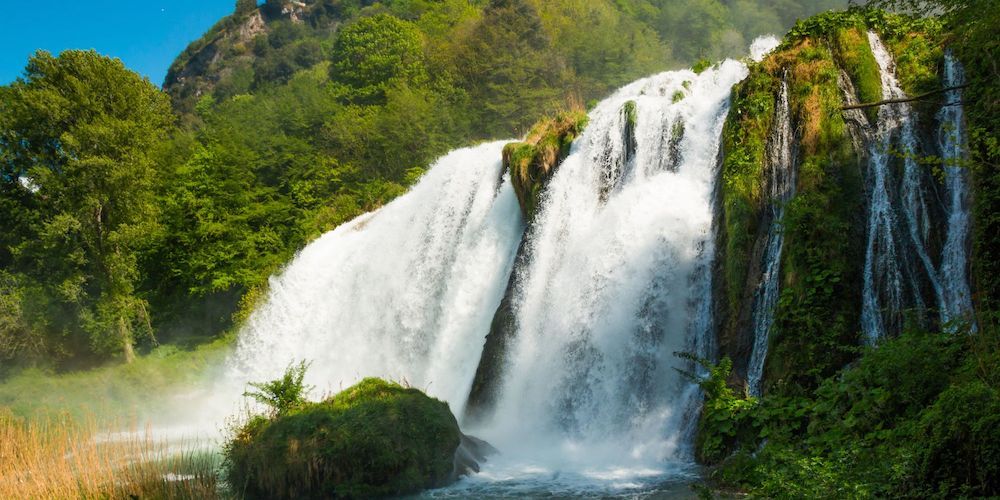
Our itinerary of 7 days in Umbria starts from Rome-Fiumicino Airport, after taking a car in one of the rental cars of this area, let’s drive following the signs towards Florence, proceeding first on the Northern ring road around Rome and then on the A1 motorway.
After about 1 hour, we take the exit of Orte and follow the road SS675: we will officially enter Umbria shortly after the village of Caldare. From this point will be just over 20 minutes to reach Terni.
Instead of entering the city, however, let’s go ahead for a dozen kilometers until we reach the southern part of the Nera River Park, where the spectacular Marmore Falls is located.
Here we must definitely stop and walk the paths surrounded by greenery, in the peace of nature disturbed only by the roar of the water that rushes wildly towards the valley, offering glimpses of dazzling beauty.
According to legend, the Marmore Falls descends from the love between the nymph Nera and the shepherd Velino: a love that was forbidden by the goddess Juno, who transformed the nymph in the Nera River. When the shepherd discovered it, he returned to the cliff of Marmore, the place where he first met Nera, and threw himself into the void to meet his beloved. Impressed by this gesture, Jupiter decided to turn Velino into water, so as to make him reunite with Nera in an eternal and indissoluble embrace.
We can better appreciate the atmosphere of this extraordinary place by looking at one of the many Viewpoints, such as the famous Balcone degli Innamorati (accessible only by guided tours, in order to protect the integrity of the environment in which it is placed).
In the afternoon, let’s go back to Terni and take a walk in the historic center to visit the picturesque Cathedral of Santa Maria Assunta and the adjacent ruins of the Roman Amphitheater, before spending the evening discovering the tasty dishes of Umbrian cuisine, such as the Ciriole alla Ternana.
Book the shuttle from Rome Termini to Rome Fiumicino2nd stage: Norcia and the Sibillini Mountains
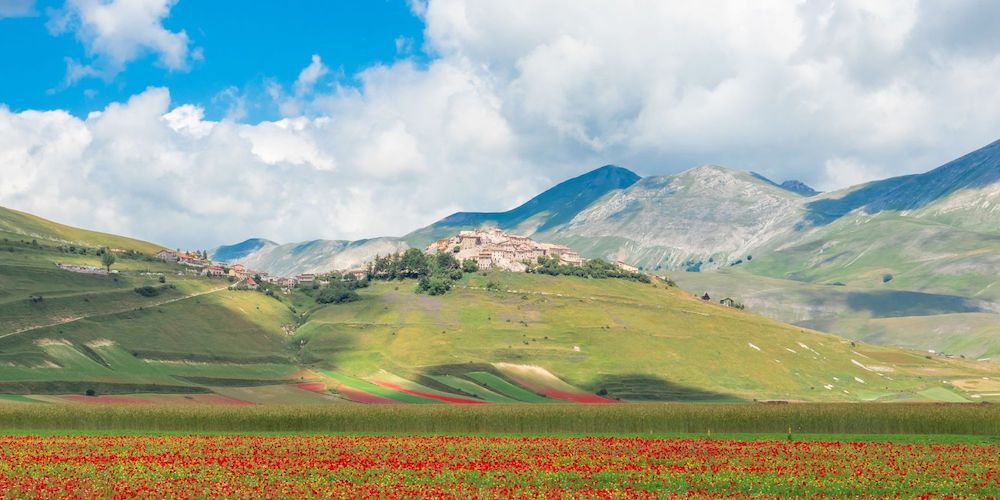
In the second stage of our itinerary of 7 days in Umbria we’ll arrive in Assisi in the evening. From Terni, the fastest road is the SS3, heading north, which leads to the "City of Peace" in just 70 kilometers, passing also through very evocative countries such as Spoleto, Foligno and Spello.
But to discover the true soul of the region, we can take reach in a little more than an hour Norcia, birthplace of San Benedetto placed in the foothills of the Sibillini Mountains.
The historic center is beautiful, in particular the charming Piazza San Benedetto, where the homonymous Basilica is located, according to tradition, in the place in which San Benedetto and Santa Scolastica from Norcia lived. Unfortunately, the building was severely damaged by the earthquake of 2016; but, with the restoration work largely already accomplished, it’s ready to return to its former glory by 2025.
Walking through the streets of Norcia, in addition, we can discover the delicious local products by entering a typical norceria, a place specialized in the processing and sale of pork, characteristic of Norcia and Umbria in general. The processing and preservation of these meats is a real art that distinguishes this area since the first centuries after Christ.
In the afternoon let’s leave the city by taking the road SP476 in the direction of the town of Preci: we would skirt the Sibillini Mountains, admiring beautiful views and immersing ourselves in the lush nature of the border area between Umbria and Marche.
Along the road, we can make a stop in the medieval village of Rasiglia, a hidden gem where we can walk through history and nature in a fascinating and unmissable environment.
From Rasiglia it takes only 40 minutes to reach Assisi, the final stage of the day. In the evening, we refresh and recover energy by trying the dishes of local cuisine, for example desserts such as the delicious Rocciata of Assisi.
3rd stage: Assisi, a journey through monuments and spirituality
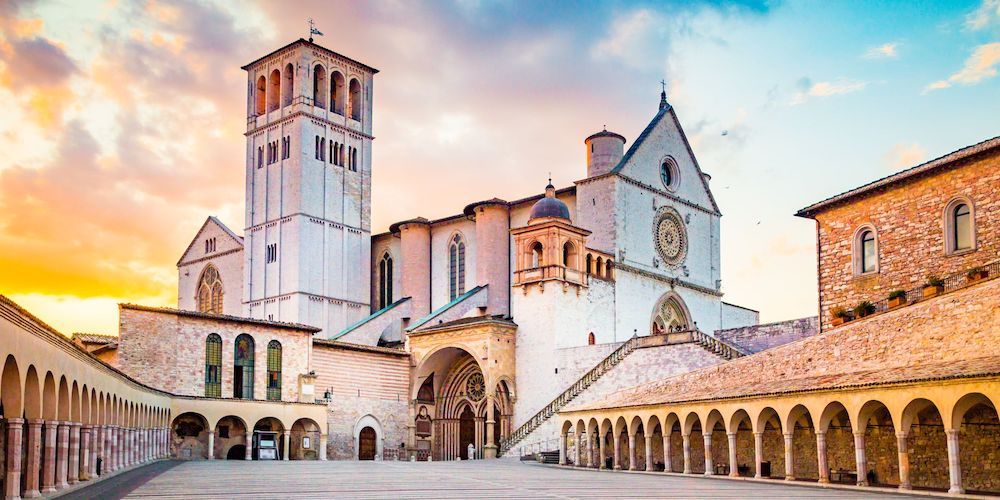
Birthplace of Saint Francis and Saint Clare, Assisi is not only to visit but also to live. We have to experience its historical and artistic aura, its natural setting, its atmosphere full of peace and spirituality.
For this reason, despite there are so many attractions to discover in Assisi, the "City of Peace" is a place to explore quietly, respectfully admiring the architectural wonders including the Basilica of Santa Chiara (13th century), the Church of Santa Maria Maggiore (11th-12th century) and the Cathedral of San Rufino (13th century), where Saint Francis was baptized.
These extraordinary religious buildings are easily accessible from the picturesque and central Piazza del Comune, where we find the Church of Santa Maria Sopra Minerva, also known as the Temple of Minerva: it was born as a Roman temple, as we can see from the beautiful columns that characterize the facade, to be then transformed into a church in the 16th century.
The square, in fact, was once the Roman Forum: that’s why there’s a small but definitely interesting Archaeological Museum.
In the afternoon, let’s leave the historic center to go to the Rocca Maggiore, a medieval fortress in a strategic position from which we can enjoy an extraordinary view of the city below and the surrounding hills.
Now that we have known some of the symbolic places and we have entered the atmosphere of pilgrimage that characterizes this territory, let’s go without hesitation to the fabulous Basilica of Saint Francis of Assisi.
The setting, architecture and atmosphere of this iconic religious building dating back to 1253 are incredible! Explore it with respect and admiration: a guided tour is probably the best way to discover all its secrets.
To the side of the Upper Basilica we also find the Bosco di San Francesco, another really fascinating point where we can walk in the nature in the footsteps of the saint.
Explore the fascinating Bosco di San Francesco4th stage: Gubbio, “Città dei Matti”

Gubbio is really a sort of “Città dei Matti” (City of Fools): unique, unpredictable and special like its inhabitants. Among spectacular squares, historic buildings and legendary traditions, this ancient medieval village captures the imagination and remains impressed in the memory of visitors.
We need less than an hour to reach Gubbio from Assisi; then we can begin to explore the city starting from the gardens of Piazza 40 Martiri, overlooked by the Church of San Francesco (do not miss the frescoes and windows inside).
Let’s walk through the picturesque streets of the city center, going up to the upper part of the village to reach the wonderful Piazza Grande, a real suspended balcony that offers fabulous views of the surrounding hilly landscape. To arrive here without any effort, we can use the free public elevator in Via Baldassini.
In the square we also find Palazzo dei Consoli, a beautiful medieval building where we can visit the Civic Museum of Gubbio and admire a breathtaking scenery from the Loggia Panoramica.
Speaking of spectacular views, especially in the case of a beautiful sunny day we absolutely have to use the Funivia Colle Eletto to climb up to the 827 meters of the Basilica of Sant'Ubaldo.
Here are the three famous Ceri, three wooden artifacts that, surmounted by the statues of Sant'Ubaldo, San Giorgio and Sant'Antonio Abate, are transported from Piazza Grande to the Basilica every May 15, on the eve of the feast of Sant'Ubaldo, in a tradition that has been repeated since the 12th century and is particularly felt by all citizens.
Then we can walk back to the town and get ready to spend the evening in one of the restaurants of the historic center, to enjoy some of the dishes or local products such as tagliatelle, grilled roasts and the famous Umbrian truffle.
5th stage: Lake Trasimeno
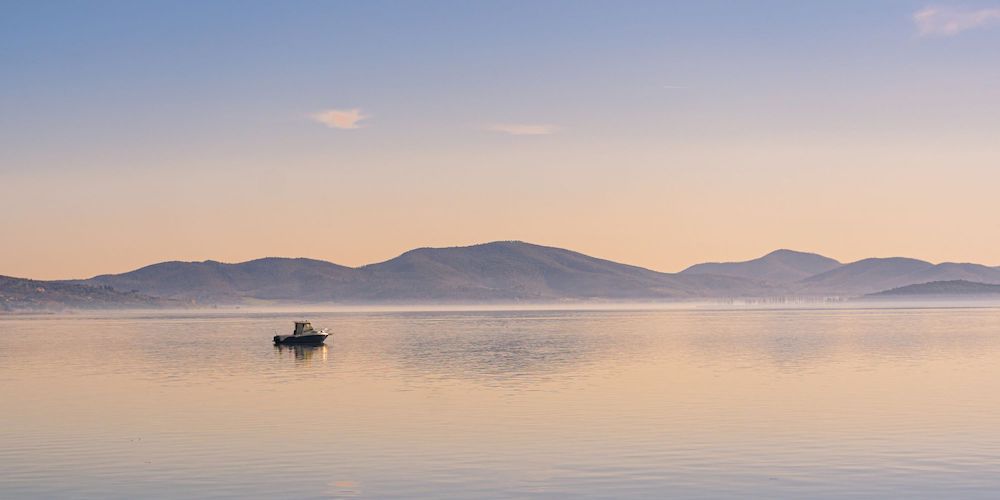
Our itinerary of 7 days in Umbria takes us to the shores of Lake Trasimeno, one hour away from Gubbio. Once there, let’s follow the road that circumnavigates the lake stopping to admire the most beautiful attractions in the area.
The first place to visit is Passignano sul Trasimeno to visit the picturesque Rocca (fortress) and admire the beautiful view from the upper terrace.
Then let’s stop again in Tuoro sul Trasimeno to learn about the history of the Battle of Trasimeno, fought by Hannibal during the Second Punic War. There’s a beautiful museum right in the center of Tuoro, as well as a path that runs for about 14 kilometers, with 13 thematic stations that tell the story of the battle.
Close to the Tuoro station, we can also take the ferry to the nearby Isola Maggiore, where we will find a castle, several churches and a chapel dedicated to Saint Francis, who came to meditate in this place.
The third attraction not to be missed is located on the western shore of Trasimeno: it’s the village of Castiglione del Lago. Here is located the historic Palazzo della Corgna, with its beautiful frescoes in the interior rooms and the breathtaking views that we can enjoy from the adjacent Rocca del Leone.
Now we can complete our circular path along the lake returning to the eastern side, in the direction of Magione, stopping in San Feliciano.
Here, in addition to a Museum dedicated to fishing and full of interesting historical information on the territory, we can take the ferry to Isola Polvese, the largest island of Trasimeno. Let’s immerse ourselves in its luxuriant nature by discovering its Rocca, the Church of San Giuliano and the Ruins of the Monastery of San Secondo.
Finally, let’s leave the shores of the lake to head to Perugia, which is less than half an hour away from San Feliciano, where we will stay the night waiting to visit the city the next day.
Lake Trasimeno and Val Chiana: explore the Terre del Perugino6th stage: Perugia, from the Etruscans to the Middle Ages
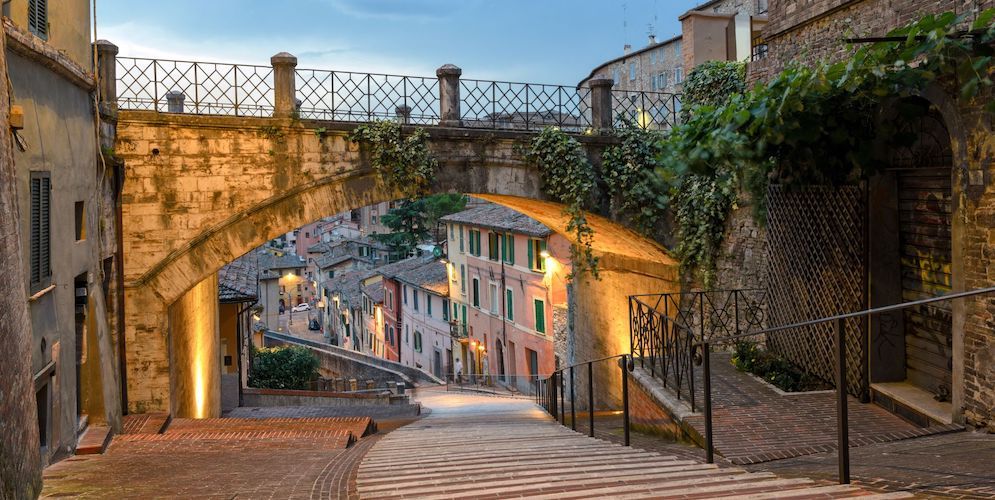
Palaces, streets, arches, churches and panoramas. In Perugia we can find all this and much more, along with a vibrant atmosphere typical of a university center and regional capital.
Where to start exploring Perugia? Perhaps from Piazza IV Novembre, a particularly suggestive medieval-style square where we can admire the Fontana Maggiore, Palazzo dei Priori with the extraordinary Sala dei Notari (late 13th century), and the Metropolitan Cathedral of San Lorenzo.
In the adjacent Piazza Danti we also find the Pozzo Etrusco, a well dating back to the 3rd century BC, very interesting to understand the history of the Etruscan period of Perugia, as well as the skills of this population in the works of hydraulic engineering.
Keep in mind that the visit is very short and the interior space is obviously quite claustrophobic: it may not be an attraction for everyone, but it is certainly very impressive. Alternatively (or in addition, why not?), it’s certainly worth taking a guided tour of the archaeological area of Perugia Sotterranea.
As we’ve seen, the visit to the central area of the city can take away at least half a day, maybe more. In the afternoon we can climb to the ancient Porta del Sole to admire a fantastic view, then continue until reaching the monumental Etruscan Arch of the 3rd century BC, and finally arrive at the medieval aqueduct of Perugia, one of the most iconic and photographed places in the city.
To space out our day, we can stop for a snack based on chocolate, local product famous throughout Italy (in the surroundings of the city there’s also a museum of Cioccolato Perugina).
In the evening, let’s not miss the opportunity to enjoy a dish of Gnocchi con sugo d’Oca (goose sauce), or a plate of Palombacci alla Perugina, before spending a cheerful evening in the many pubs and nightlife of the old town.
7th stage: Todi and Orvieto
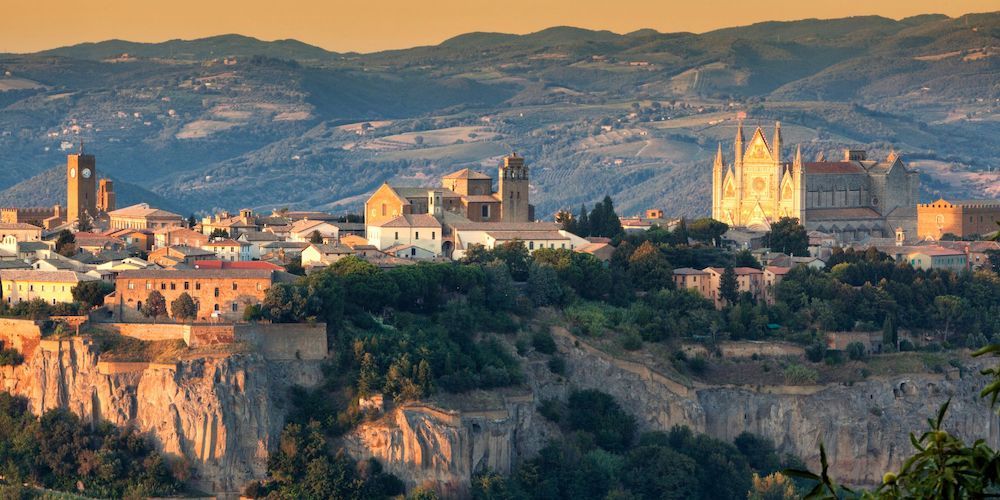
Before concluding our 7 days in Umbria, there are still a couple of lovely places to discover in this last stage.
The first is the village of Todi, located about forty kilometers south of Perugia. In the beautiful Piazza del Popolo we can appreciate the charming facade and the beautiful interior of the Cathedral of the Santissima Annunziata, as well as the Palazzo dei Priori of the late 13th century.
After spending a couple of hours visiting the historic center, maybe with a short stop for lunch to enjoy excellent local products such as the wine (Todi DOC) and typical dishes like Pasticcio di Jacopone (a roll of puff pastry stuffed with meat, vegetables, ricotta and spices), let’s leave Todi to head to Orvieto, less than an hour away.
Here we can not miss the Duomo, a fabulous Gothic church built between late 13th and late 16th century, which towers over the square with its imposing facade. The interior is not less than the exterior, with frescoes, sculptures and artworks that testify to the importance and history of this site.
Leaving the Duomo, let’s reach Corso Cavour to go towards the historic Pozzo di San Patrizio, where according to legend the saint used to pray and propose to his faithful hard tests for the expiation of sins to entry into heaven. We can visit the well by going down its 239 steps: of course the hard part is climbing them to get out!
The well closes at 4:30. We can then spend the rest of the afternoon walking through the Orvieto historic center and admiring other beautiful monuments, such as the Torre del Moro and the Palazzo del Capitano del Popolo.
We are now at the end of our journey. Once we leave Orvieto, it will take about an hour and a half to return to Rome and end our journey of 7 unforgettable days among nature, culture and the timeless charm of the wonderful Umbria.
Return to Rome and discover it with the Visit Rome PassAbout the author
Written on 05/02/2024

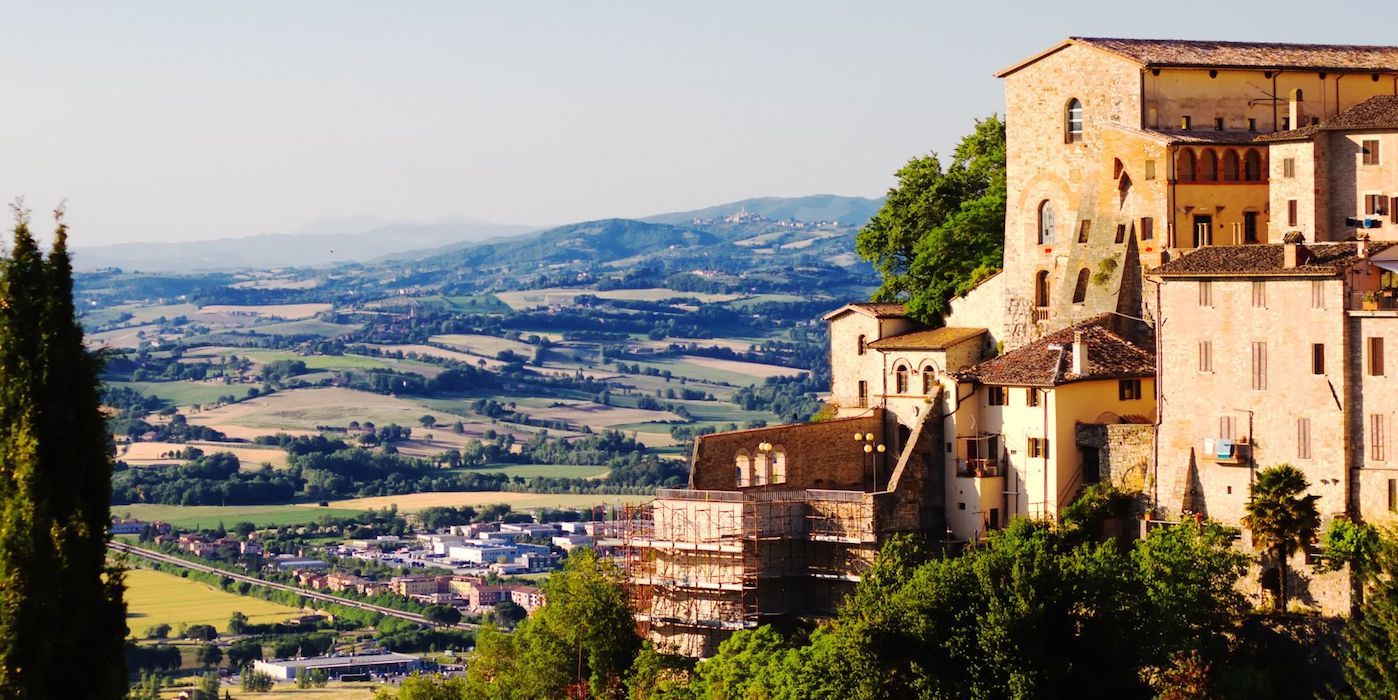

Alessandro Savino
In our itinerary of 7 days in Umbria, we’ll travel to discover the historic villages and unspoiled nature of this unique and special region.